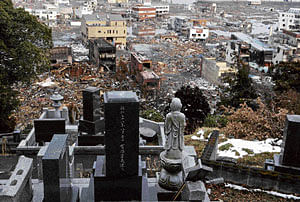No food, water... woes keep mounting

With no water or electricity, and scant food, they keep each other company at one of three emergency shelters on the outskirts of what remains of the town. “You can’t wash your hands or face,” says 72-year-old Katsu Sawayama, seated in the middle of the high school gymnasium, the biggest shelters in the town where more than half the 17,000 residents are still missing.
Adding to their woes, an unseasonal snowstorm sent temperatures plunging to below zero and blanketed acres of tsunami debris in white.
While international attention has been focused on Japan’s efforts to stop damage at a nuclear power plant from spiralling out of control, a massive rescue operation has slowly been gathering steam.
Scores of villages, hamlets and towns lining Japan’s northeast coast were flattened by tsunami waves that rolled in minutes after Friday’s 9.0 magnitude earthquake.
While the official toll stands at less than 5,000, thousands more are listed as missing and the final tally is likely to soar.
About 8,50,000 households in the north were still without electricity in near-freezing weather, Tohuku Electric Power Co. said, while the government said at least 1.5 million households lacked running water. Like tens of thousands of people along Japan’s northeast coast, the Otsuchi survivors have nowhere else to go.
Meals are barely enough to sustain them — half a rice ball and a small bowl of miso soup is a luxury; a slice of bread might have to feed a family of three.
“Whatever they give us, we just gratefully receive. At least they are feeding us three times a day,” said Sayawama. International experts feel that panic over fears of radiation leak from the Daiichi nuclear plant could detract from problems likely to affect the survivors.
“People are getting so concerned about what are at the moment pretty low levels of radiation,” said Dr Richard Wakeford of Britain’s University of Manchester, “but the real problems are in dealing with the earthquake and tsunami.”
“If this was a developing country, we’d have people going down in their hundreds and thousands with the likes of typhoid and cholera by now. The questions should be: Where is the sewage going? What is the state of the drinking water? If I were a public health official, that would be my prime concern.” What worries Ayumi Yamazaki, 21, is that her one-and-half-year-old daughter is not getting enough to eat.
Sense of order
Despite the privations there is a sense of order in the evacuation centre. In late afternoon, a neat queue forms in one hallway of the refuge shelter for men under 60 years old to collect clean undergarment sent in through charity.
Outside help is slowly and sparingly arriving. A Self Defence Forces’ truck carrying water arrived late afternoon on Wednesday, and two Red Cross teams arrived for the first time to treat patients. “It’s cold today so many people have fallen ill, getting diarrhoea and other symptoms,” said Takanori Watanabe, a Red Cross doctor from Himeji, western Japan.
Elsewhere there were signs of human touches. Two soldiers picked through the rubble and placed personal effects such as photographs in a box so that survivors might be able to reclaim cherished memories.
“They belong to someone. You never know,” said one.
Deccan Herald is on WhatsApp Channels| Join now for Breaking News & Editor's Picks